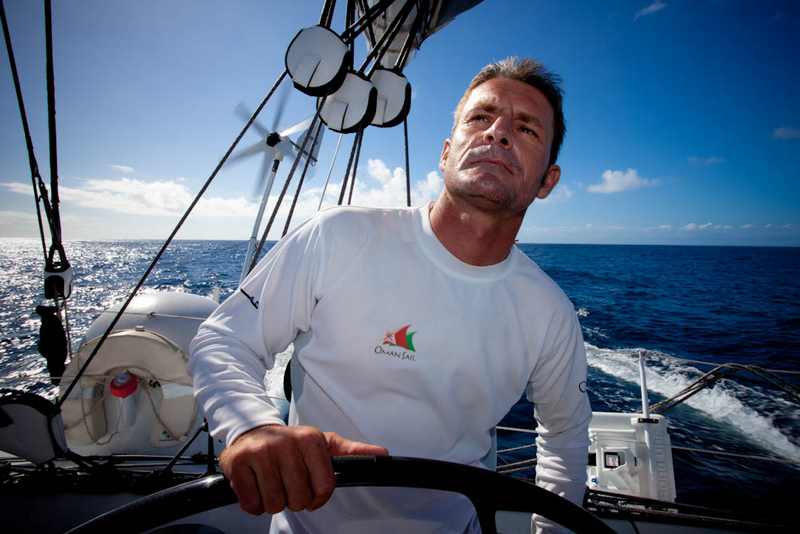
Oman Sail’s A100 trimaran ‘Majan’ arrived in Fremantle the 24th of March 2010 at 10:00 (Local Time – 2:00 am GMT), after having crossed the longitude of Cape Leeuwin, the third cape of the Indian 5 Ocean Capes Race and the finish line of Leg 3 on Monday, 22nd of March at 04:10 GMT. It has been yet another eventful leg for the A100 trimaran and her crew as they trace out this new race course ahead of the official edition in 2012, and an Indian Ocean crossing that will leave its mark durably on the minds of the Oman Sail team members.
For most sailors, even the most seasoned ones, the odds of one day getting to the very top of the Beaufort scale are quite low. But “thanks” to the Indian Ocean’s wrath, Majan’s men have been through a hurricane on their way to Cape Leeuwin and as Mark Covell puts it, “The experience of 70+ knots is now something that will stay with us for the rest of our lives.” It might be hard to figure out seen from dry land, but winds that strong and the resulting sea state definitely give the term of “survival” its legitimacy, both for men and machine. The A100, designed to withstand the fiercest conditions on all the world’s oceans, has proven its worth and the teams who have worked on her build and assembly, both at BoatSpeed Australia and at Oman Sail’s dedicated facility, should today feel very proud of the work carried out. Majan’s crew led by Paul Standbridge and including Sidney Gavignet who will go on to race in the solo Route du Rhum this November on ‘Majan’, relied on the boat to make it through the hurricane, and as they made it safely back ashore it is thanks to their outstanding seamanship, but also thanks to the inherent reliability and seaworthiness of the trimaran.
Extreme team-bonding
One can only imagine the unspoken anguish, the heavy silences, the anxious glances at the mast, the shrouds or the beams connecting floats and central hull – “Please don’t break!”, can we easily imagine the sailors silently addressing the boat whilst she was taking a major beating. In that kind of situation, each wave slamming on the structure and each gust taking the rigging to unprecedented stress levels is physically felt by the crew, with that horribly sinking feeling that yes, the breaking point is near – and if things break, there goes the solid ground under your feet. On a multihull, that feeling is amplified by the awareness that flipping over can be easily done without great seamanship… the boat heels at the top of 8 to 10-metre waves, and there’s no lead bulb to keep her upright. The magic of flying machines does have its drawbacks, and multis have, as Loïck Peyron once put it, that “strange tendency to be much more stable capsized than upright”. Quite a scary thought when you’re thousands of miles away from land.
The fury of the elements was bound to take its toll on the Omani crew – Mohsin Al Busaidi may be the first Arab to sail non-stop round the world but the most breeze he saw was 55 knots and for offshore ‘novice’ Mohammed Al Ghailani, he was certainly not lost for words when it was time to describe the experience: “I felt very scared at first. All the parts coming together were too much for me. The wind, the rain, the noise all built up, I didn’t like it. I sat in the cockpit with Mike and Paul. They made me feel much better because they were okay and not frightened. I was in all my wet whether gear and I still felt cold and wet. When I took it off later I was dry but the water in the air made me feel soaking wet and cold. I didn’t sleep at all on my off watch and that always makes things hard.”
11 days, 18 hours and 48 minutes after having crossed the starting line of Leg 3 in Cape Town, Majan cut through an imaginary line south of Cape Leeuwin, the southwestern tip of Australia. They had to cope – somewhat ironically – with a light patch on the final stretch towards Fremantle, just after turned the “left indicator” on. Fortunately the breeze picked up rapidly and by early afternoon (GMT) the crew was back at more than 16 knots, looking forward to a decent hot meal and a night in a comfortable bed, with its four fleet firmly planted on the floor!

About Fremantle
Located 12 miles southwest of Perth, at the entrance of the Swan River, Fremantle was established in 1829 and is renowned for its quality of life. With its active fishing port, the city offers a wide variety of restaurants and seafood cafés, and its cultural life also attracts a lot of visitors. Official stopover of the Indian Ocean 5 Capes Race, Fremantle has a strong nautical tradition, having hosted the 1987 America’s Cup and will next year welcome the ISAF Sailing World Championships.